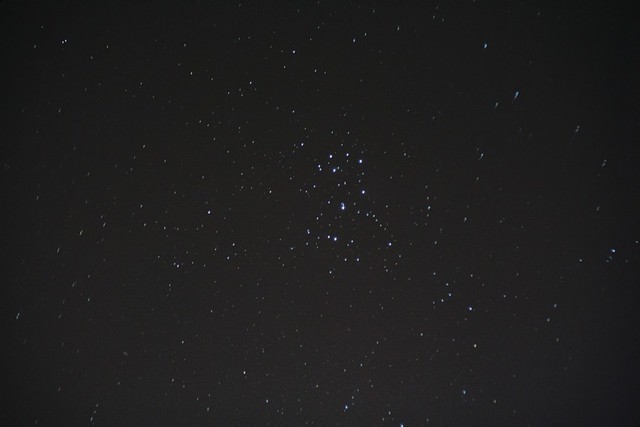Shooting the stars
This month's issue of Make Magazine (12) had a short article titled "Shoot the Stars: Astrophotography with your digital SLR." I have always had an interest in astronomy, but I hadn't really considered just pointing my existing DSLR setup at the night sky without a telescope, tracking system, &etc.
But, as it turns out, a good CCD imager like the one in my Canon Digital Rebel XT is all you really need to start taking some neat pictures of the night sky! As a test I took the following images from the alley behind my house in downtown Atlanta, under a severe amount of light pollution.
I've just scratched the surface of astrophotography once before with my father's Celestron scope and an Orion digital imager, and learned then that having good post-processing software is half the battle. After doing some searching, I decided to give the freeware DeepSkyStacker a spin.
My first target was the Pleiades (M45), as they're relatively easy to spot in the night sky and rose early. I equipped my Canon with my Sigma 70-300mm f/5.6 zoom lens and set it up on the tripod. I took a series of exposures in increasing increments of time until the stars were noticeably blurry when zoomed in, and then backed off one. The following is a composite of about 35 exposures at 4 seconds each. Focal length: 165mm.

(click the image to view)
Next, I got ambitious. I knew the Andromeda Galaxy was directly overhead, about half-way between Cassiopeia and the half-moon. I scanned the sky visually for a few minutes, but the light pollution was such that there weren't really even any stars visible in the general vicinity of the great galaxy. On a lark, I pulled the focal length all the way back to 70mm and pointed the camera straight up. I took a 30 second exposure, and then zoomed in and panned around the thumbnail on the camera display. There it was, a cotton-like disc on the left-center region. So, I panned left and repeated until the galaxy was essentially centered.
1st is a composite of several 15 second exposures @ 100mm, ISO 800, 2nd is a composite of 8 second exposures at 70mm focal length, ISO 1600:


I'm sufficiently impressed. Next I'm going to have to take the camera out to a dark sky somewhere and do some "real" exposures to see what I come up with!
But, as it turns out, a good CCD imager like the one in my Canon Digital Rebel XT is all you really need to start taking some neat pictures of the night sky! As a test I took the following images from the alley behind my house in downtown Atlanta, under a severe amount of light pollution.
I've just scratched the surface of astrophotography once before with my father's Celestron scope and an Orion digital imager, and learned then that having good post-processing software is half the battle. After doing some searching, I decided to give the freeware DeepSkyStacker a spin.
My first target was the Pleiades (M45), as they're relatively easy to spot in the night sky and rose early. I equipped my Canon with my Sigma 70-300mm f/5.6 zoom lens and set it up on the tripod. I took a series of exposures in increasing increments of time until the stars were noticeably blurry when zoomed in, and then backed off one. The following is a composite of about 35 exposures at 4 seconds each. Focal length: 165mm.

(click the image to view)
Next, I got ambitious. I knew the Andromeda Galaxy was directly overhead, about half-way between Cassiopeia and the half-moon. I scanned the sky visually for a few minutes, but the light pollution was such that there weren't really even any stars visible in the general vicinity of the great galaxy. On a lark, I pulled the focal length all the way back to 70mm and pointed the camera straight up. I took a 30 second exposure, and then zoomed in and panned around the thumbnail on the camera display. There it was, a cotton-like disc on the left-center region. So, I panned left and repeated until the galaxy was essentially centered.
1st is a composite of several 15 second exposures @ 100mm, ISO 800, 2nd is a composite of 8 second exposures at 70mm focal length, ISO 1600:


I'm sufficiently impressed. Next I'm going to have to take the camera out to a dark sky somewhere and do some "real" exposures to see what I come up with!



Interesting. I have a 10" Dobsonian that I quit using because of light pollution. I might see if I can find a way to connect the 30D to that and use the stacker program to merge the images!
ReplyDelete